Home » Gemstones » Gemstone Inclusions
Looking into the Mysteries of Gems with a Microscope
Author: Hobart M. King, PhD, GIA Graduate Gemologist
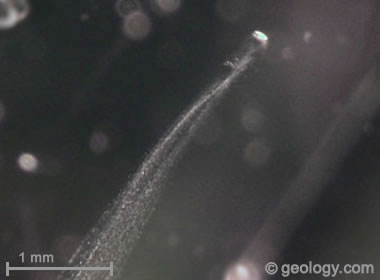
Comet Tail Inclusion in Topaz: It looks like a comet flying through a gemstone. Instead it is a tiny crystal of an unidentified mineral that started to grow on the surface of a much larger topaz crystal. The tiny crystal made it difficult for the topaz below it to grow properly - it had become an obstacle to growth. As the topaz crystal expanded, it pushed the tiny crystal in the direction of growth, and a wispy stream of inclusions within the topaz was the result.
A microscope is one of the most commonly used tools of the gemologist. They use microscopes to grade gemstones, identify gemstones, separate natural gems from synthetics, determine the probable country of origin of gems, and learn how gems have formed. They also use microscopes to examine the quality of cutting and polishing done on a gem, and check gems for potential damage.
In this article you will see interior views of a variety of gems. Instead of focusing on the surface of the gem, we will lower the focus to look at their transparent or translucent interiors. Several of these views show features that gemologists use to identify synthetic gems. If you have never looked at the interior of gems with a microscope, several will be interesting inclusions or foreign objects that you never realized were hiding in your gems.
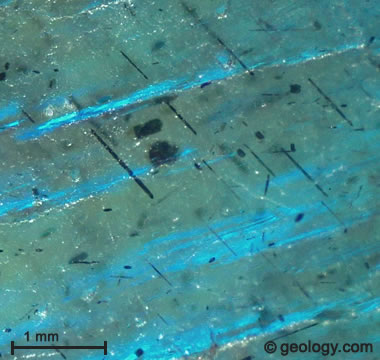
Tourmaline Arrows Pierce Labradorescence: You are looking into a piece of yellowish gray labradorite perpendicular to the planes that produce the labradorescent flash. The electric blue reflections from those planes slope upwards from left to right across the width of this image. These labradorescent planes are pierced by tiny crystals of what appears to be schorl tourmaline that range in size up to about 1 millimeter in length. Illumination is from the upper-left side of the image.
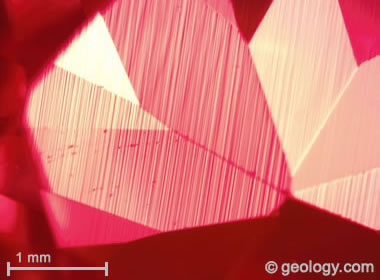
Growth Lines in Synthetic Ruby: Examination with a microscope provides some of the strongest evidence for the synthetic manufacturing of ruby and other varieties of corundum. In the flame fusion synthesis method, growth lines develop in the crystal as the boule turns under the material feed. Near the center of the boule, these growth lines have a strong curvature. Near the outer circumference of the boule, the growth lines have a much gentler curvature. The growth lines can be difficult to see. They are only visible when viewed at a limited range of angles under certain lighting conditions. The growth lines in this synthetic ruby are very coarse. Their crossing of facet junctions confirms that they are within the stone and are not polishing lines on facet surfaces.
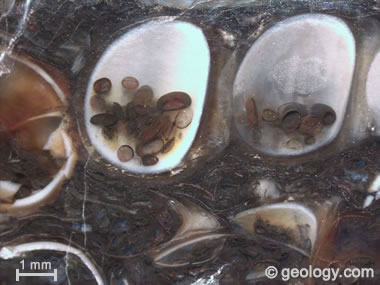
Looking Closely at Turritella: Many people might think that the chalcedony portion of Turritella Agate is brown in color. In many specimens the chalcedony is actually colorless and crystal clear. The brown color is caused by an enormous number of fossilized ostracod shells within the agate. In this specimen, the space between the macrofossils are is filled by a small amount of plant debris, some colorless chalcedony and an enormous number of ostracod fossils that can only be recognized with magnification. Even the whorls of the hollow Turritella fossils contain large numbers of ostracods. This specimen of Turritella is from the highly fossiliferous Green River Formation. Enlarge image.
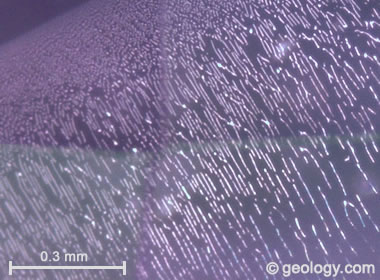
Fingerprint Inclusions in Sapphire: This image is looking into the pavilion of a faceted sapphire. The blurry "+" that divides the view into unequal quadrants is the junction formed between four adjacent facets. The swarm of bright squiggles is a network of fingerprint inclusions that are trapped within a fracture plane that bisects the gem.
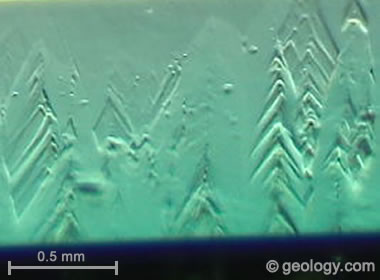
Chevron Growth Features in Synthetic Emerald: Microscopic examination provides some of the best evidence for separating natural emerald from synthetic emerald. The inverted "V" shapes in this image are chevron growth features, one of the best evidences of a synthetic origin in emerald.
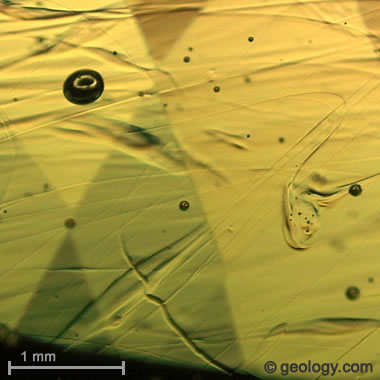
Chaos in Moldavite: Moldavite is a gem that is cut from a green glass that formed when an asteroid slammed into what is now eastern Europe. The force of the hypervelocity impact flash-melted rocks in the impact area, and they condensed and solidified as they flew through the atmosphere. Numerous bubbles and flow lines in the moldavite provide evidence of the material’s violent creation.
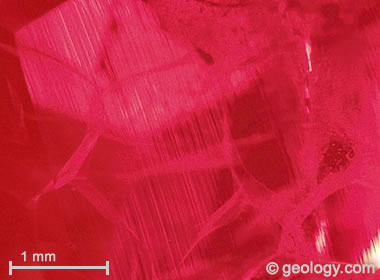
Trying to Fool Gemologists? You are looking down through a ruby that is broken by a honeycomb-shaped network of fractures. The diagonal and slightly curved striations are strong evidence that this ruby is synthetic. It is possible that this synthetic ruby was quench crackled to ruin its perfect clarity and make it look more like a natural ruby - both to the naked eye and through a microscope.
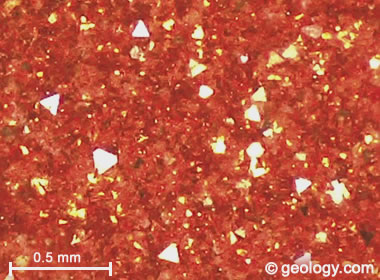
Copper Crystals in Goldstone: You are looking through a microscope at a polished surface of reddish brown goldstone. A bright light is shining down onto the surface of the goldstone. The triangular faces of octahedral copper crystals are reflecting the light back at you from various depths below the polished surface of the transparent glass. The largest triangular crystal face seen in this view is about 0.1 millimeters from apex to base.
| More Gemstones |
 |
Tourmaline |
 |
Fancy Sapphires |
 |
Diamond |
 |
Canadian Diamond Mines |
 |
Birthstones |
 |
Pictures of Opal |
 |
Fire Agate |
 |
Blue Gemstones |

Find Other Topics on Geology.com:

|

| ||

|

| ||

|

| ||

|

|
